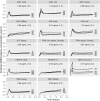Clinical Pharmacokinetics and Pharmacodynamics of Dexmedetomidine
- PMID: 28105598
- PMCID: PMC5511603
- DOI: 10.1007/s40262-017-0507-7
Clinical Pharmacokinetics and Pharmacodynamics of Dexmedetomidine
Abstract
Dexmedetomidine is an α2-adrenoceptor agonist with sedative, anxiolytic, sympatholytic, and analgesic-sparing effects, and minimal depression of respiratory function. It is potent and highly selective for α2-receptors with an α2:α1 ratio of 1620:1. Hemodynamic effects, which include transient hypertension, bradycardia, and hypotension, result from the drug's peripheral vasoconstrictive and sympatholytic properties. Dexmedetomidine exerts its hypnotic action through activation of central pre- and postsynaptic α2-receptors in the locus coeruleus, thereby inducting a state of unconsciousness similar to natural sleep, with the unique aspect that patients remain easily rousable and cooperative. Dexmedetomidine is rapidly distributed and is mainly hepatically metabolized into inactive metabolites by glucuronidation and hydroxylation. A high inter-individual variability in dexmedetomidine pharmacokinetics has been described, especially in the intensive care unit population. In recent years, multiple pharmacokinetic non-compartmental analyses as well as population pharmacokinetic studies have been performed. Body size, hepatic impairment, and presumably plasma albumin and cardiac output have a significant impact on dexmedetomidine pharmacokinetics. Results regarding other covariates remain inconclusive and warrant further research. Although initially approved for intravenous use for up to 24 h in the adult intensive care unit population only, applications of dexmedetomidine in clinical practice have been widened over the past few years. Procedural sedation with dexmedetomidine was additionally approved by the US Food and Drug Administration in 2003 and dexmedetomidine has appeared useful in multiple off-label applications such as pediatric sedation, intranasal or buccal administration, and use as an adjuvant to local analgesia techniques.
Conflict of interest statement
Funding
Only departmental funding was used to assist with the preparation of this review.
Conflict of Interest
Maud A. S. Weerink, Laura N. Hannivoort, Clemens R. M. Barends, and Pieter Colin have no conflicts of interest to declare. Michel M. R. F. Struys’s research group/department received grants and funding from The Medicines Company (Parsippany, NJ, USA), Masimo (Irvine, CA, USA), Fresenius (Bad Homburg, Germany), Acacia Design (Maastricht, The Netherlands), and Medtronic (Dublin, Ireland); and he has received honoraria from The Medicines Company (Parsippany, NJ, USA), Masimo (Irvine, CA, USA), Fresenius (Bad Homburg, Germany), Baxter (Deerfield, IL, USA), Medtronic (Dublin, Ireland), and Demed Medical (Temse, Belgium). Anthony R. Absalom’s research group/department received grants and funding from The Medicines Company (Parsippany, NJ, USA), Masimo (Irvine, CA, USA), Fresenius (Bad Homburg, Germany), Acacia Design (Maastricht, The Netherlands), and Medtronic (Dublin, Ireland); and he has received honoraria from The Medicines Company (Parsippany, NJ, USA) and Janssen Pharmaceutica NV (Beerse, Belgium).
Figures

References
-
- US Food and Drug Administration. Precedex label. 1999. Available from: http://www.accessdata.fda.gov/drugsatfda_docs/label/1999/21038lbl.pdf. Accessed 14 Nov 2016.
-
- European Medicines Agency. European Public Assessment Report. 2016. Available from: http://www.ema.europa.eu/docs/en_GB/document_library/EPAR_-_Product_Info.... Accessed 14 Nov 2016.
Publication types
MeSH terms
Substances
LinkOut - more resources
Full Text Sources
Other Literature Sources
Medical
Molecular Biology Databases
Miscellaneous

